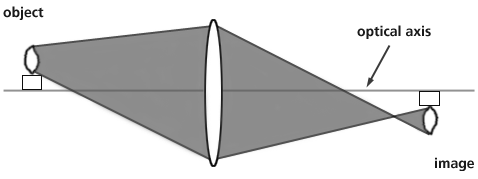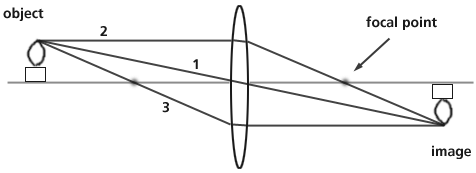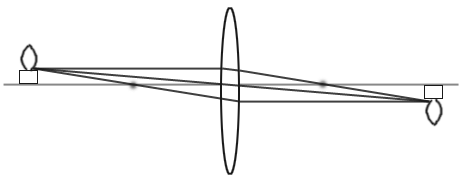
Ray Tracing, or Where Should the Ant Move?
We've seen how we can find the focal length of various types of lenses, and what the difference is between a real and a virtual image. Now we need to bring these concepts together so we can use them to our advantage.Let's pretend for a moment that we live in a world in which the optometrists or opthamologists won't make our eyeglasses or contact lenses. If you had the raw materials and knew the prescription of your eyes (the eye doctors will at least do that service), how could you find the right lenses to make? We could make some lenses and test them until we found the right ones, but this might make our eyes pretty tired and would take a long time. If we knew the focal length of various lenses, we would be able to use a much more powerful technique to make our glasses.
Ray tracing allows us to "see" how light is going to behave when we have lenses and mirrors in the path of the light. If we know where the focal point of each lens and mirror is, we can figure out where the image of a certain object will be formed. This will tell us where the image will fall on our retina so we can see it.
The idea is to draw light rays emanating from the object through the optical system (lenses & mirrors). The diagram below shows how much of the light from the light source (a candle) passes through the lens and is imaged on the other side (notice that the ray that started at the top of the candle ends up below the ray that started at the bottom of the flame: the image is upside down).

Since there are an uncountable number of light rays (shaded area above) passing through the lens(es), it would be unreasonable to draw them all. Usually, we need draw only 2 or 3 rays from a point on the light source to represent all the rays coming from that point.
If we know the focal length of each of the lenses and/or mirrors, our 3 rays will show us where the image of a point from the source (or object) will be located.

In the diagram above, I chose "special" rays to locate the image: the ray (1) passing through the center of the lens will always travel in a straight line without refracting; the ray (2) coming straight in from the candle top (parallel to the optical axis) is bent so it passes through the focal point on the other side of the lens; and the ray (3) passing through the focal point on the object (the left) side of the lens will be refracted so the light will exit the lens travelling parallel to the optical axis. A very similar diagram could be drawn for the light rays coming from the bottom of the candle, or from any other point on the candle.

With this technique of tracing various rays from a light souce, we can tell where an image will form and how it will be oriented: inverted or upright. Now, go make those glasses!
First Page of Lenses Reading
Second Page of Lenses Reading
Page authored by the
ACEPT W3 Group
Department of Physics and Astronomy, Arizona State University, Tempe, AZ 85287-1504
Copyright © 1995-2000 Arizona Board of Regents. All rights reserved.